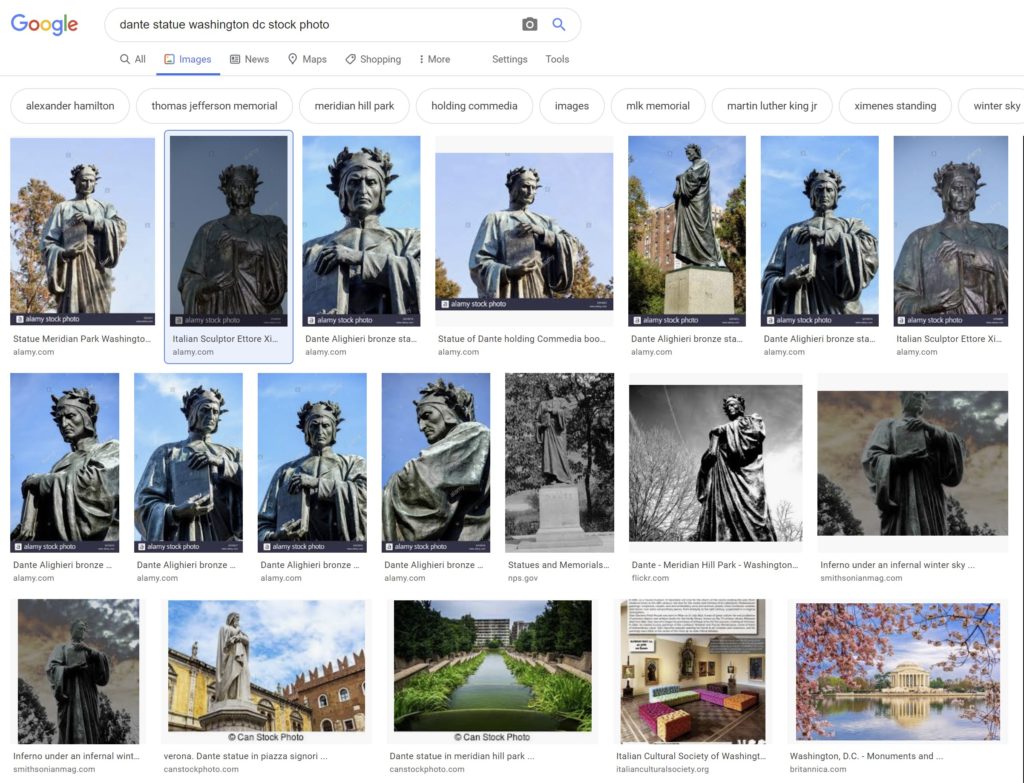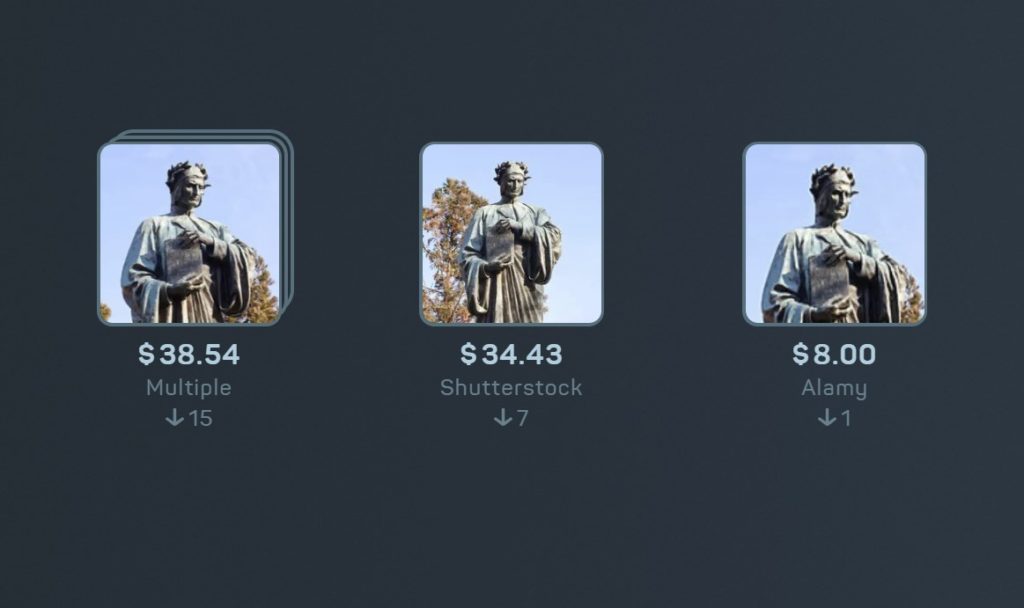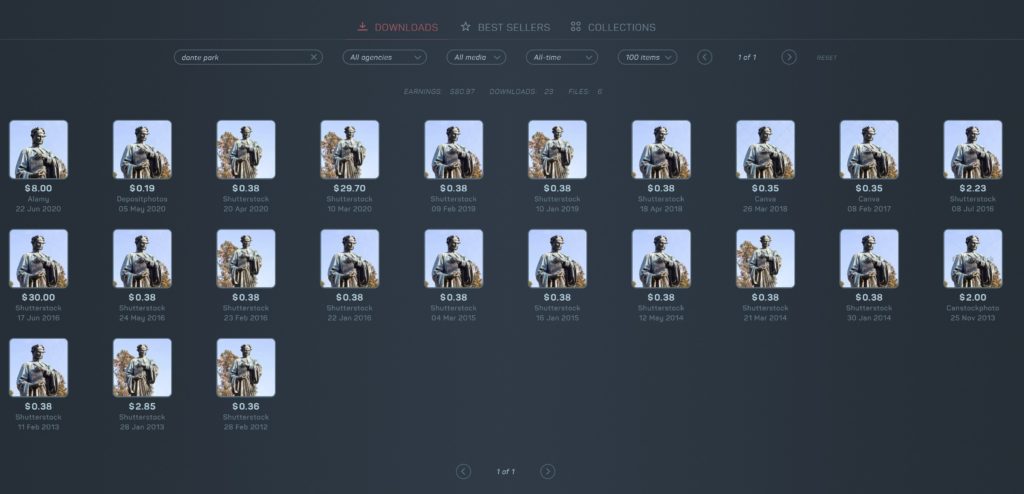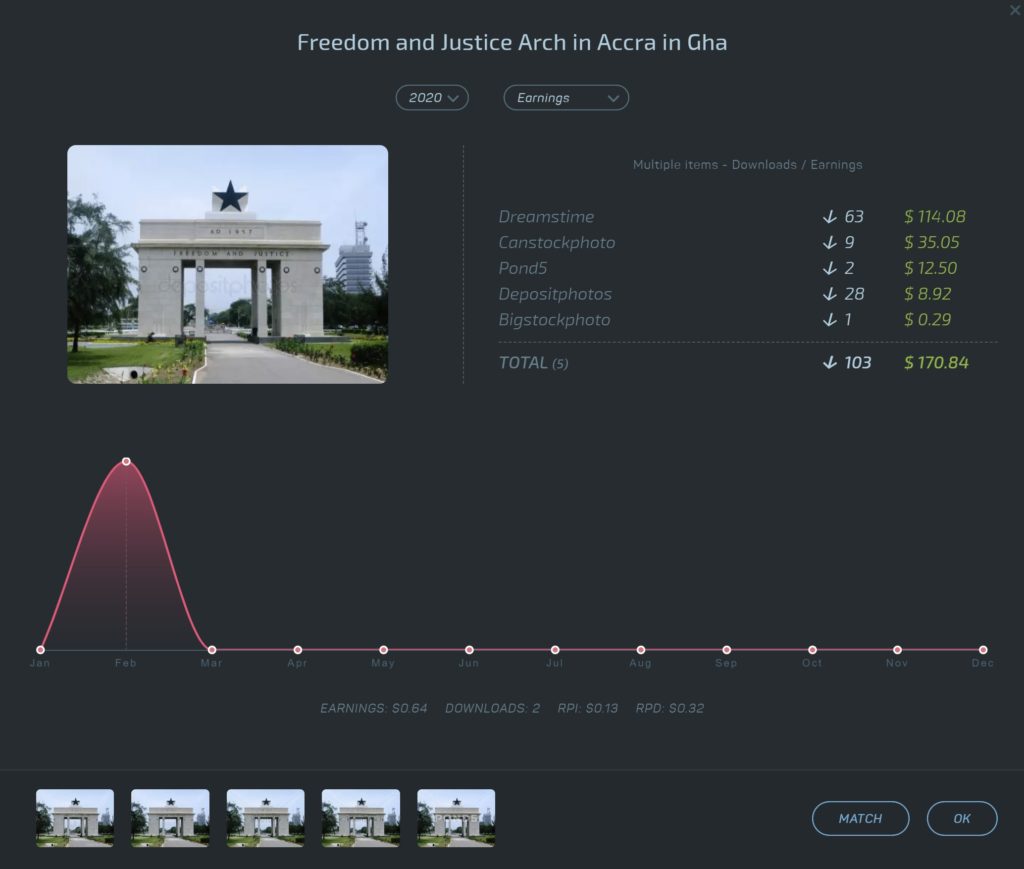How to maximize your earnings?
This is the follow up article to the one I published earlier this week about the value we put on our art“. Although I talk a lot about “images”, I’m using that as a bit of a shorthand to include videos as well. The key message that I ended with in that article was the following:
Your aim should be to maximize the earnings of your portfolio with the minimum effort needed to achieve those earnings
Exclusivity – a club for you?
Firstly, a word about exclusivity. There are stock agencies where you can be an exclusive contributor (iStock was a big proponent of this in the past) and you received a higher share of the purchase price. There are others such as Pond5 where you can mark some assets as exclusive and put a higher price on them and gain an extra share of that price as well. Alamy also has an exclusive setting. I can see the benefit of this to the agency – they get imagery that can’t be found elsewhere and a dominant agency (as iStock arguably was in the early days) can market this as a real advantage to buying from them. But what is the benefit to the buyer? Exclusivity to them means that no-one else can use that image, so that if they license it for a product, similar products with the same image won’t appear. But that is not what is being offered here – in fact, I would argue that the current use of “Exclusive” could put some buyers off – they get nothing and they have to sign up to an agency they haven’t used before to use that image and they may have to pay more for it as well?? Do any of us really believe that our images and videos are so unique that someone would go out of their way, sign up for an account and pay more to use that specific image? There must be rare cases where this is true, but I remain convinced that “exclusive” is a good marketing pitch for an agency, but brings few benefits to a contributor.
Multiple agencies, then?
I think there are maybe three basic types of buyer.
- An employee of a company where the company maintains an account at one or more agencies and the employee is required to use those agencies
- A self employed buyer obtaining images for their own site or use with a subscription type account at one of the major agencies. They are unlikely to have an account at more than one
- A self employed buyer looking for images on a case by case basis and buying them as required
Only the latter buyer would normally search on Google images to find the sort of image they want (maybe checking the images from free stock sites first) and then buying what they want from the site that both has the image in question and is reasonably priced. The other two categories will tend to start with their chosen agencies and only go elsewhere if they can’t find something suitable. So to maximize our earnings, we should be on all the agencies that buyers are likely to use – subject to the final clause in my statement above “with the minimum effort”. I’ve written extensively about the use of Stock Submitter and Microstock Plus as key tools to allow me to support 15 or so agencies with no extra effort above that needed to support just one. I’m amazed with the comments on the Shutterstock forum about people searching now for agencies beyond just Shutterstock – threatening to upload to Adobe, for instance, or talking to Pond5 about uploading images there. For goodness sake – what were these people thinking? How could they have thought they were stock photographers and only uploading to one agency?
It seems absolutely clear to me that if you want to maximize your earnings, you must submit to multiple agencies. The only question is whether you should submit all your images to every agency, or save your “best” images for agencies that pay more for each download? The most obvious current example is Alamy where net payments of over $100 are not that rare. Other sites have higher value collections – Getty for instance – although getting in there is very difficult I believe, unless you get in via partners such as EyeEM. This question of maximizing your earnings by selective uploads is what I really want to concentrate on.
Ideal world scenarios
If every stock agency paid about the same amount of money, then submitting to all would be the most sensible approach. That would catch all our three groups of buyers outlined above. Of course, they aren’t all the same. The other ideal scenario would be if all contributors decided to put their best images on Alamy, say, and it became known that for those sort of images, Alamy was the only place to go and you needed to pay for those images. Of course, we know what happens when you try to herd cats…
We struggle as well, with what sort of images are “best” and command a higher payment? In the good old days of high quality magazines, National Geographic would pay dearly for world class photographers to spend months on an article and would be willing to license new images at high prices to keep their magazine at the top of the quality charts. What is today’s equivalent? I’ve no idea and I struggle to see what sort of image these days would command a massive premium when we talk about “quality” or “artistic merit”. I know that Alex Rotenberg spent a lot of effort choosing his best shots and submitting on an exclusive basis to Robert Harding, where they went through an editor who finally chose what they would accept. His results from that have been pitiful.
What was suggested in that Alamy forum post I mentioned in the previous article was that scarce or difficult to find (or take) images should command a higher premium, especially if the usage was such that the writer needed to use a photo of that specific item in their article. There was a sort of unwritten thought that if photographers understood this and put common photos on microstock and scarce images on Alamy, then we would all benefit from higher prices on those images. That made me think as I have my own collection of images of out of the way places and things that you could argue should do best on Alamy. So here is the result of my investigation.
Dante Alighieri
Out of the way in Washington DC is a statue of Dante Alighieri. I went there in 2012 and took a few pictures and uploaded them (as is my wont) to all agencies. This statue is well off any tourist areas to Washington and so only a local or dedicated stock photographer would go there and take the time to keyword and upload it. Why am I talking about this? I saw a sale this week for $8 net on Alamy and thought this was an ideal example of a scarce image that people should search for and pay for. It is not the sort of thing that would be used generically to advertise a vacation in Washington DC, after all.

So if someone really needed this image for a story, how would they find it? Starting with Google images, I find this:

I included the words “stock photo” in the search so I got images that you could actually purchase. I still get mainly Alamy images without this restriction. Some of those are mine, but other photographers have been there as well. So this would seem to suggest that if I had put my image solely on Alamy, I would have got the best price for this image? That was the surprise, though. Here are my results over the years on these images:

And splitting this out into individual sales:

What is interesting here is that there were two sales for almost $30 on Shutterstock – one in March this year and one back in 2016. Now you could argue that if I had only had this image on Alamy in 2016, I would have got a much higher priced sale back then – that could be true.
The Bottom Line
What does this tell us? Would some effort on my part in separating out images from my various travels (I think this analysis is more about remote or offbeat places and things) into ones that had generic appeal for any article about a place or region that would go to the microstock sites and other more specialized or unique images solely going to Alamy have generated more income? This one-off analysis of one image might suggest no – I got sales of this image from people that presumably started searching on the agency they had an account with and found my image. Would they have been allowed to use Alamy and pay more? Would they have used something similar from the agency they started with? I can’t answer that either, unfortunately. And how would I decide what would be specialized and destined for Alamy and what would go to the cheaper microstock agencies? I don’t really know how to answer that.
I looked through my best seller list on Microstockr Pro to see which image I would count as being “off the beaten track” and I was almost at the bottom of page 2 (of 100 images each) before I found this one of Accra:

And, as you can see, this has sold on multiple “microstock” sites. Would it have done better just on Alamy – again, it is hard to say!
So my conclusion is that without a consistent approach from many contributors to only put these scarce images on higher paying sites (which will never happen), and with the difficulty in defining what is a scarce image (without searching the databases of the main agencies for each image that “might” make the cut), I still come down on the side of uploading all images to all sites. I know I am probably hurting fellow photographers who only submit to Alamy, I’m probably helping to devalue photography as a paying profession, but this is a global industry without rules, I’m afraid.







I have never sold an image that I marked as exclusive, and I have a few in Dreamstime, Alamy. Fotolia used to allow for that too, so I have a few there as well. On the other hand, I once uploaded to multiple agencies an image taken at the Sonoma coast which was quite unique. I should have done some research before uploading it everywhere, but I did not. Well after a number of copies had sold in every agency I have an account with, I received a proposal from Shutterstock to license it exclusively to them, for 2,500. I did not even know SS had that kind of service. Well, after I told them where I had the image and how many times it had sold already, they backed off. Lesson: if you think you may have a unique photograph, really unique rather than one more version of the same thing, then go through the trouble to mark it as exclusive… although for instance ss would not have known about it if had not uploaded it there… catch 22
I didn’t know of that Shutterstock scheme – presumably a while ago? I doubt if you could have predicted that you have an image that is good enough to be paid for by the agency themselves! So I wouldn’t kick yourself too much about it.
The offer came a little before the pandemics but when COVID-19 hit they told me the deal had to be cancelled. It was a travel image.
Wow – so recent. I had not heard of anything like that
P.S. edited to add: I like the fact that you makes such rational points about things based on data. Lots of the discussions about stock photography are emotional rants about things people believe to be true and can’t have it any other way. Your approach is … scientific. I like that.
I have a degree in Physics from London University – that might help! But I do like to think about these things from both our point of view as contributors but also what the buyer and the agency might be trying to achieve as well.
Oh that explains your fondness for data 😉
First of all, I would like to thank Steve, as well as all the others here who share their insights, especially being a newbie to the microstock world. There is one quote in this post that really gave rise to a lot of reflection: “I know I am probably hurting fellow photographers who only submit to Alamy, I’m probably helping to devalue photography as a paying profession, but this is a global industry without rules, I’m afraid.”
I have been practicing photography for almost 60 years, and at least 50 of those years I was able to make a reasonable living, keeping body and soul together.
But this has all changed. Our relationship as a society to photographs has changed and so has the ubiquity of the photograph. Paul Melcher noted almost 6 years ago that there were 2 billion photographic images uploaded everyday, 365 days a year. I’m sure its more now. When you have an abundance of something, generally the price goes down, not up.
Also, the technology has made it so easy to produce a decent photograph, so the cost of entry and the skill level necessary to get into this game has been considerably reduced.
Interesting, that this topic of “how do I make more money doing photography” keeps getting rehashed about every 7 to 10 years, and it’s always about what the flavour of the month was in the photography business. I could replace the word “stock” with any other description, like food, wedding or corporate, and it was essentially the same story.
The brutal truth is that practitioners of photography who try to derive an income from sole photography have always had a pretty dodgy precarious lifestyle. This is just another act in the play.
It used to be a sole proprietorship type of thing, and if you were reasonably successful, possibly a corporation with staff, but now it’s as if we’re all indie musicians or filmmakers using these micro marketplaces to eke out some renumeration for what we like to do. To quote Chris Anderson, its The Long Tail, selling less of more. It’s the iTunes model where the artist or developer gets a tiny little slice, but the provider of the service gets the bulk of the renumeration, simply because they basically own what Adam Smith calls the “means of production”, the way of getting our products to market.
Shutterstock is, for all intents and purposes, unprofitable, if you take the time to delve into the financials. All of the stock industry over theist 50 years has gone through this creative destruction as purveyors of content seek to lower their costs, so someone comes up without again a different plan to get photography cheaper than before, and now it’s gone to zero, somewhat like interest rates.
I think everyone should read the Wikipedia entry for Shutterstock, and also Microstock. It puts the business in context
I think it’s probably better for one’s psychological well being to just practice photography and get your reward from the journey, if you can afford to. If you make some money, or even haul it in in wheelbarrows it like Steve does, well all the more power to you. Take it when you can, because it may not always be that way, at least with this particular business model, or the next one
If you’re in it soley for the money, you’re bound to be disappointed. Over my time I’ve seen a lot of highs and lows. This is not even a real low, just a bit of a downward curve.
And here’s something that wouldn’t surprise me, I’ll bet the revenues fall from here, because no matter which way you look at it, most of these images, and videos get used in some type of advertising. That business is going through a really bad time, along with the rest of the western economies, and without it, that marketing component, I find it really hard to see the remuneration increasing
Thanks for your very full reply! Very on-point as well. It is interesting to hear the more historical perspective as well and I totally agree that this particular phase will run its course and perhaps something else will take its place. Certainly being a wedding photographer must be particularly tough right now – or even that favorite of nature professionals right now – the workshops or tours.
Steve
hi steve ,not a long time ago i become exclusive on pond 5 but after i read your article , i begin ask am i make a mistake ? ,but my situation a little different, i just delete all my footages (500 footages) other sites and just left them on pond 5, i begin upload same time and on pond5 i earn 220$ same time SS 20$ and istock 10$ so in my situation what u think did i make a mistake ? and my 2nd question , when im making new footages can i change camea ankle and make another footage for other sites ( SS İSTOCK) and upload them? thanks
I think the market for video is smaller in terms of the agencies. The point I was trying to make about Pond5 is that trying to get a higher price on Pond5 than similar videos that are not exclusive to them and are priced lower is unlikely to work unless your clips are noticeably better or more unique than the other Pond5 ones. So exclusivity of an agency is not something that is valuable to a buyer (I don’t think). As to whether a buyer who has an account with Shutterstock, say, will search for your specific video because they aren’t finding one that meets their needs on SS also depends on the uniqueness of your video. If the buyer on SS finds something that meets their needs, then you have potentially lost a sale. If your clips really are unique and they leave SS to find you on Pond5, then you have a higher value sale. So it all depends on the uniqueness of your videos I think. My main point on images is that it is hard to be unique these days with so many images around.
Steve (I normally go by Steve so I deleted your other comment!)
thank you so much for explanation
Hi Steve, thanks for the very insightful info!! I was wondering, do you need to mark this photo of Dante’s Statue as editorial? Perhaps not in 2012, but when I searched this statue’s photos on Shutterstock, they have been marked as editorial lately. But again, different agency applies different rules, these editorial and commercial things are so confusing…
I don’t think so – the statue was a replica casting of one in Dante park in New York and it was donated to and installed in Washington in 1921. So even if it was original in 1921 it would be no longer copyright in the US and as it is a replica the original artist must be long gone. So I think I was right in 2012, but as you say, the agencies set the rules! They don’t want to have to research every piece of artwork that is uploaded and so they err on the side of caution. This sort of image is unlikely to sell much better as commercial rather than editorial and of course, buyers can use as they want. So just go with the flow!
Steve